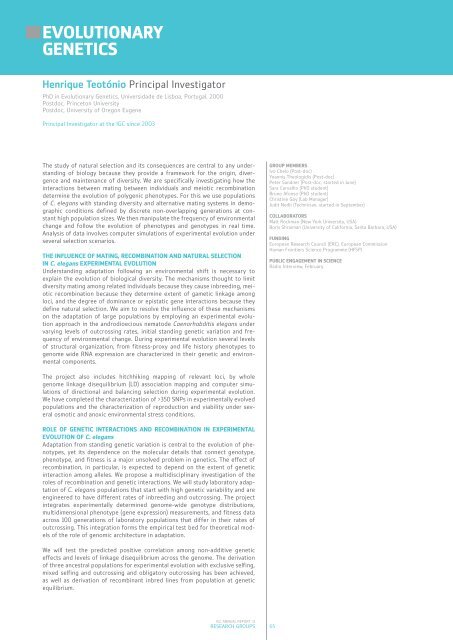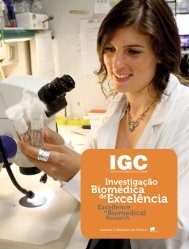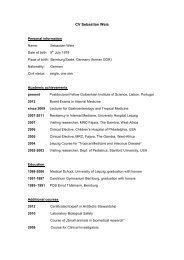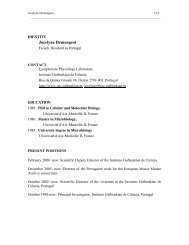organisation - the Instituto Gulbenkian de Ciência
organisation - the Instituto Gulbenkian de Ciência
organisation - the Instituto Gulbenkian de Ciência
- No tags were found...
You also want an ePaper? Increase the reach of your titles
YUMPU automatically turns print PDFs into web optimized ePapers that Google loves.
EVOLUTIONARY<br />
GENETICS<br />
Henrique Teotónio Principal Investigator<br />
PhD in Evolutionary Genetics, Universida<strong>de</strong> <strong>de</strong> Lisboa, Portugal, 2000<br />
Postdoc, Princeton University<br />
Postdoc, University of Oregon Eugene<br />
Principal Investigator at <strong>the</strong> IGC since 2003<br />
The study of natural selection and its consequences are central to any un<strong>de</strong>rstanding<br />
of biology because <strong>the</strong>y provi<strong>de</strong> a framework for <strong>the</strong> origin, divergence<br />
and maintenance of diversity. We are specifically investigating how <strong>the</strong><br />
interactions between mating between individuals and meiotic recombination<br />
<strong>de</strong>termine <strong>the</strong> evolution of polygenic phenotypes. For this we use populations<br />
of C. elegans with standing diversity and alternative mating systems in <strong>de</strong>mographic<br />
conditions <strong>de</strong>fined by discrete non-overlapping generations at constant<br />
high population sizes. We <strong>the</strong>n manipulate <strong>the</strong> frequency of environmental<br />
change and follow <strong>the</strong> evolution of phenotypes and genotypes in real time.<br />
Analysis of data involves computer simulations of experimental evolution un<strong>de</strong>r<br />
several selection scenarios.<br />
THE INFLUENCE OF MATING, RECOMBINATION AND NATURAL SELECTION<br />
IN C. elegans EXPERIMENTAL EVOLUTION<br />
Un<strong>de</strong>rstanding adaptation following an environmental shift is necessary to<br />
explain <strong>the</strong> evolution of biological diversity. The mechanisms thought to limit<br />
diversity mating among related individuals because <strong>the</strong>y cause inbreeding, meiotic<br />
recombination because <strong>the</strong>y <strong>de</strong>termine extent of gametic linkage among<br />
loci, and <strong>the</strong> <strong>de</strong>gree of dominance or epistatic gene interactions because <strong>the</strong>y<br />
<strong>de</strong>fine natural selection. We aim to resolve <strong>the</strong> influence of <strong>the</strong>se mechanisms<br />
on <strong>the</strong> adaptation of large populations by employing an experimental evolution<br />
approach in <strong>the</strong> androdioecious nemato<strong>de</strong> Caenorhabditis elegans un<strong>de</strong>r<br />
varying levels of outcrossing rates, initial standing genetic variation and frequency<br />
of environmental change. During experimental evolution several levels<br />
of structural organization, from fitness-proxy and life history phenotypes to<br />
genome wi<strong>de</strong> RNA expression are characterized in <strong>the</strong>ir genetic and environmental<br />
components.<br />
GROUP MEMBERS<br />
Ivo Chelo (Post-doc)<br />
Yoannis Theologidis (Post-doc)<br />
Peter Sandner (Post-doc, started in June)<br />
Sara Carvalho (PhD stu<strong>de</strong>nt)<br />
Bruno Afonso (PhD stu<strong>de</strong>nt)<br />
Christine Goy (Lab Manager)<br />
Judit Nedli (Technician, started in September)<br />
COLLABORATORS<br />
Matt Rockman (New York University, USA)<br />
Boris Shraiman (University of California, Santa Barbara, USA)<br />
FUNDING<br />
European Research Council (ERC), European Commission<br />
Human Frontiers Science Programme (HFSP)<br />
PUBLIC ENGAGEMENT IN SCIENCE<br />
Radio Interview, February<br />
The project also inclu<strong>de</strong>s hitchhiking mapping of relevant loci, by whole<br />
genome linkage disequilibrium (LD) association mapping and computer simulations<br />
of directional and balancing selection during experimental evolution.<br />
We have completed <strong>the</strong> characterization of >350 SNPs in experimentally evolved<br />
populations and <strong>the</strong> characterization of reproduction and viability un<strong>de</strong>r several<br />
osmotic and anoxic environmental stress conditions.<br />
ROLE OF GENETIC INTERACTIONS AND RECOMBINATION IN EXPERIMENTAL<br />
EVOLUTION OF C. elegans<br />
Adaptation from standing genetic variation is central to <strong>the</strong> evolution of phenotypes,<br />
yet its <strong>de</strong>pen<strong>de</strong>nce on <strong>the</strong> molecular <strong>de</strong>tails that connect genotype,<br />
phenotype, and fitness is a major unsolved problem in genetics. The effect of<br />
recombination, in particular, is expected to <strong>de</strong>pend on <strong>the</strong> extent of genetic<br />
interaction among alleles. We propose a multidisciplinary investigation of <strong>the</strong><br />
roles of recombination and genetic interactions. We will study laboratory adaptation<br />
of C. elegans populations that start with high genetic variability and are<br />
engineered to have different rates of inbreeding and outcrossing. The project<br />
integrates experimentally <strong>de</strong>termined genome-wi<strong>de</strong> genotype distributions,<br />
multidimensional phenotype (gene expression) measurements, and fitness data<br />
across 100 generations of laboratory populations that differ in <strong>the</strong>ir rates of<br />
outcrossing. This integration forms <strong>the</strong> empirical test bed for <strong>the</strong>oretical mo<strong>de</strong>ls<br />
of <strong>the</strong> role of genomic architecture in adaptation.<br />
We will test <strong>the</strong> predicted positive correlation among non-additive genetic<br />
effects and levels of linkage disequilibrium across <strong>the</strong> genome. The <strong>de</strong>rivation<br />
of three ancestral populations for experimental evolution with exclusive selfing,<br />
mixed selfing and outcrossing and obligatory outcrossing has been achieved,<br />
as well as <strong>de</strong>rivation of recombinant inbred lines from population at genetic<br />
equilibrium.<br />
IGC ANNUAL REPORT ‘11<br />
RESEARCH GROUPS<br />
65






